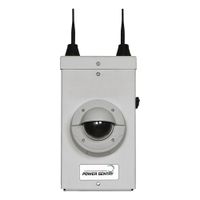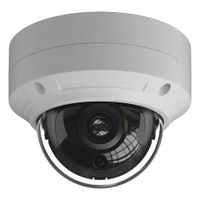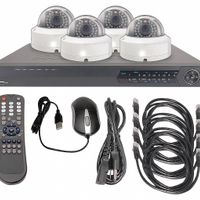Call +(254) 703 030 000 / 751 483 999 / 721 704 777
- Home
- Security
- Video Surveillance
- Video Surveillance Cameras Systems
.....Read More
Frequently Asked Questions
What are the benefits of using video surveillance cameras for security?
Video surveillance cameras offer numerous benefits for security, enhancing safety and protection in various environments. They act as a deterrent to criminal activities, as the presence of cameras can discourage potential offenders from engaging in illegal actions. This preventive measure helps reduce theft, vandalism, and other crimes.
Surveillance cameras provide real-time monitoring, allowing security personnel to observe activities as they happen. This capability enables quick responses to incidents, potentially preventing escalation and minimizing damage or loss. Additionally, recorded footage serves as valuable evidence in investigations, aiding law enforcement in identifying and prosecuting offenders.
The use of video surveillance enhances situational awareness, enabling security teams to monitor multiple areas simultaneously. This comprehensive coverage ensures that no blind spots are left unmonitored, increasing overall security effectiveness. Moreover, advanced systems equipped with features like motion detection and facial recognition can automate threat detection, alerting security personnel to suspicious activities.
Video surveillance also contributes to operational efficiency. By monitoring employee behavior and adherence to protocols, businesses can ensure compliance with safety regulations and improve productivity. In public spaces, surveillance helps manage crowd control and traffic flow, enhancing public safety and convenience.
Furthermore, remote access to surveillance systems allows for monitoring from any location, providing flexibility and convenience for security management. This feature is particularly beneficial for large organizations with multiple sites, as it centralizes security operations.
In summary, video surveillance cameras offer deterrence, real-time monitoring, evidence collection, enhanced situational awareness, operational efficiency, and remote access, making them a vital component of modern security strategies.
How do IP video surveillance systems work?
IP video surveillance systems work by using Internet Protocol (IP) networks to transmit video data. These systems consist of IP cameras, network video recorders (NVRs), and network infrastructure.
1. **IP Cameras**: These cameras capture video footage and convert it into digital data. Unlike analog cameras, IP cameras have built-in processing capabilities to compress and encode video data, often using formats like H.264 or H.265, which reduces bandwidth and storage requirements.
2. **Network Infrastructure**: The digital video data is transmitted over an IP network, which can be a local area network (LAN), wide area network (WAN), or the internet. This network can be wired, using Ethernet cables, or wireless, using Wi-Fi. Power over Ethernet (PoE) technology is often used to supply power to cameras through the same cable used for data transmission, simplifying installation.
3. **Network Video Recorders (NVRs)**: NVRs are used to store and manage the video data. They can be hardware devices or software applications running on a server. NVRs receive video streams from IP cameras over the network, allowing for centralized storage and management. They provide features like video playback, live viewing, and video analytics.
4. **Video Management Software (VMS)**: VMS is used to control and manage the video surveillance system. It provides a user interface for viewing live and recorded video, configuring camera settings, and setting up alerts and notifications. Advanced VMS solutions offer features like motion detection, facial recognition, and integration with other security systems.
5. **Remote Access**: IP video surveillance systems allow for remote access via web browsers or mobile apps, enabling users to monitor live feeds and review footage from anywhere with an internet connection.
Overall, IP video surveillance systems offer scalability, flexibility, and advanced features compared to traditional analog systems.
What is the difference between analog and digital video surveillance systems?
Analog video surveillance systems use traditional CCTV cameras to capture video footage, which is then transmitted over coaxial cables to a recording device, typically a DVR (Digital Video Recorder). The video is stored in analog format, and the quality is often limited by the resolution capabilities of the camera and the recording device. Analog systems are generally easier to set up and are cost-effective for basic surveillance needs. However, they offer lower resolution and less flexibility in terms of remote access and integration with other systems.
Digital video surveillance systems, on the other hand, use IP (Internet Protocol) cameras to capture video footage, which is then transmitted over a network to a recording device, usually an NVR (Network Video Recorder). The video is stored in digital format, allowing for higher resolution and better image quality. Digital systems offer greater flexibility, as they can be easily integrated with other network-based systems and accessed remotely via the internet. They also support advanced features like motion detection, facial recognition, and video analytics.
In summary, the main differences between analog and digital video surveillance systems lie in the method of video transmission, image quality, flexibility, and feature set. Analog systems are simpler and more cost-effective for basic needs, while digital systems offer superior image quality, scalability, and advanced features for more comprehensive surveillance solutions.
How can video surveillance deter theft and vandalism?
Video surveillance deters theft and vandalism by serving as a visible and psychological deterrent. The presence of cameras signals to potential offenders that their actions are being monitored, increasing the perceived risk of being caught. This heightened risk discourages criminal behavior, as individuals are less likely to engage in illegal activities when they know they are being watched.
Surveillance systems also provide real-time monitoring, allowing security personnel to respond promptly to suspicious activities. This immediate response capability can prevent crimes from occurring or escalating. Additionally, recorded footage serves as valuable evidence in identifying and prosecuting offenders, further discouraging criminal acts due to the increased likelihood of apprehension and legal consequences.
Moreover, video surveillance contributes to a sense of security among employees, customers, and the general public, fostering a safer environment. This enhanced security can lead to increased business patronage and community trust, as people feel more protected in areas with visible surveillance.
In summary, video surveillance acts as a deterrent by increasing the perceived risk of detection and apprehension, enabling rapid response to incidents, and providing evidence for legal proceedings, all of which contribute to reducing theft and vandalism.
What are the best practices for installing video surveillance cameras?
1. **Assess Needs and Objectives**: Determine the purpose of surveillance, such as deterring crime, monitoring activities, or ensuring safety. Identify key areas that require monitoring.
2. **Select Appropriate Cameras**: Choose cameras based on location (indoor/outdoor), lighting conditions (day/night), and specific features (e.g., motion detection, high resolution).
3. **Optimal Placement**: Install cameras at entry and exit points, high-traffic areas, and blind spots. Ensure they cover wide angles and critical areas without obstructions.
4. **Height and Angle**: Mount cameras high enough to prevent tampering but low enough to capture clear images. Adjust angles to minimize glare and maximize coverage.
5. **Lighting Considerations**: Ensure adequate lighting for clear footage. Use infrared or low-light cameras in poorly lit areas. Avoid direct sunlight or bright lights that can cause glare.
6. **Weatherproofing**: For outdoor cameras, ensure they are weatherproof and can withstand environmental conditions. Use protective housings if necessary.
7. **Secure Wiring**: Conceal and protect cables to prevent tampering. Use conduit or run cables through walls or ceilings.
8. **Network and Power**: Ensure a reliable power source and network connection. Consider PoE (Power over Ethernet) for simplified installation.
9. **Data Storage and Management**: Choose appropriate storage solutions, such as cloud storage or local DVR/NVR systems. Ensure sufficient capacity for retention needs.
10. **Legal Compliance**: Adhere to local laws and regulations regarding surveillance, privacy, and data protection. Inform individuals of surveillance where required.
11. **Regular Maintenance**: Schedule routine checks to ensure cameras are functioning correctly, lenses are clean, and software is updated.
12. **Professional Installation**: Consider hiring professionals for complex installations to ensure optimal performance and compliance with standards.
How do mobile surveillance systems differ from fixed systems?
Mobile surveillance systems differ from fixed systems in several key aspects:
1. **Mobility**: Mobile systems are designed for movement and can be deployed in various locations as needed, whereas fixed systems are permanently installed in a specific location.
2. **Flexibility**: Mobile systems offer greater flexibility, allowing for rapid deployment and repositioning to address changing surveillance needs. Fixed systems are limited to their installed locations.
3. **Coverage Area**: Mobile systems can cover multiple areas over time, providing dynamic surveillance capabilities. Fixed systems are limited to monitoring a predefined area.
4. **Installation and Setup**: Mobile systems typically require less installation time and can be operational quickly. Fixed systems often involve more complex installation processes, including wiring and infrastructure setup.
5. **Power Source**: Mobile systems often rely on battery power or portable generators, while fixed systems are usually connected to a stable power source.
6. **Data Transmission**: Mobile systems may use wireless networks for data transmission, which can be less stable than the wired connections often used by fixed systems.
7. **Cost**: Mobile systems can be more cost-effective for temporary or short-term surveillance needs, while fixed systems may require a larger initial investment but can be more economical for long-term monitoring.
8. **Applications**: Mobile systems are ideal for temporary events, law enforcement operations, and situations requiring rapid response. Fixed systems are suited for ongoing security needs, such as monitoring buildings or infrastructure.
9. **Technology**: Both systems can utilize similar technologies, such as cameras and sensors, but mobile systems may incorporate additional features like GPS for location tracking.
10. **Maintenance**: Mobile systems may require more frequent maintenance due to their exposure to varying environments, while fixed systems benefit from stable conditions.
What are the legal considerations for using video surveillance in public and private spaces?
Legal considerations for using video surveillance in public and private spaces include:
1. **Privacy Laws**: Surveillance must comply with privacy laws, such as the General Data Protection Regulation (GDPR) in the EU or the Privacy Act in the US, which regulate the collection, storage, and use of personal data.
2. **Consent**: In private spaces, obtaining consent from individuals being recorded is often required. In public spaces, implied consent may be assumed, but clear signage indicating surveillance is typically necessary.
3. **Purpose Limitation**: Surveillance should have a clear, legitimate purpose, such as security or crime prevention, and not be used for unauthorized purposes.
4. **Data Minimization**: Only necessary data should be collected, and excessive or irrelevant data collection should be avoided.
5. **Data Security**: Collected footage must be securely stored to prevent unauthorized access, breaches, or misuse.
6. **Retention Policies**: Data should be retained only for as long as necessary to fulfill its purpose and then securely deleted.
7. **Access and Disclosure**: Access to surveillance footage should be restricted to authorized personnel, and disclosure to third parties should comply with legal requirements.
8. **Impact Assessments**: Conducting privacy impact assessments can help identify and mitigate risks associated with surveillance.
9. **Notification and Signage**: Clear and visible signs should inform individuals of surveillance, detailing the purpose and contact information for further inquiries.
10. **Regulatory Compliance**: Adherence to local, state, and federal regulations governing surveillance is essential, as laws can vary significantly by jurisdiction.
11. **Employee Monitoring**: In workplaces, employee monitoring must respect labor laws and collective agreements, ensuring it is proportionate and justified.
12. **Legal Recourse**: Individuals should have the right to challenge surveillance practices and seek redress if their rights are violated.



